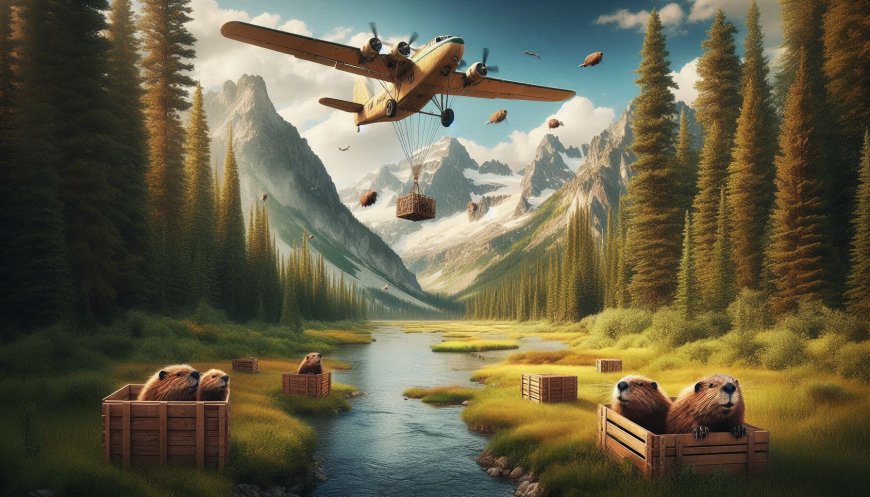The Great Beaver Drop: Idaho’s Wildest Airlift
Discover the fascinating story of Idaho's "Great Beaver Drop," a unique wildlife conservation effort in the 1940s where beavers were airlifted into remote wilderness areas to restore ecosystems. Explore this wild adventure in Idaho’s history.

More than seventy years ago, deep in the rugged wilderness of Idaho, something extraordinary was happening in the skies. No, it wasn’t a plane full of supplies, soldiers, or even cargo. It was beavers—76 of them—parachuting from the clouds into their new homes. It might sound like the setup for a wild joke, but it’s a true story of innovation, wildlife management, and one man’s vision to solve an unusual problem.
Urban Beavers and a Big Dilemma
In the late 1940s, Idaho faced an unexpected issue: beavers, once peaceful denizens of rivers and lakes, had become unwelcome guests in urban areas. As cities like McCall expanded, these industrious creatures found themselves causing havoc—clogging up waterways, flooding residential areas, and gnawing on trees in the middle of town. It was clear they needed to be relocated, but the big question remained: how?
Transporting the beavers by land wasn’t feasible. Horses and mules were terrified of the critters, and Idaho’s rough terrain made ground transport slow and costly. That’s when one man, Elmo Heter of Idaho Fish and Game, hatched a plan so daring, so unconventional, it would go down in history as one of the quirkiest wildlife relocations ever attempted.
Elmo Heter’s Sky-High Solution
Heter, an officer tasked with solving Idaho’s beaver problem, looked at the surplus of military parachutes left over from World War II and had an epiphany: why not use them to airlift beavers into the wilderness? It was risky, sure, but with no better alternatives, the idea took flight—literally.
But before the plan could become reality, Heter had to devise a container sturdy enough to protect the beavers during their skyward adventure. After scrapping early designs made of willow, which the beavers began chewing through mid-flight, Heter created a wooden box that would open upon landing.
The next step was to find a volunteer for the first test. Enter Geronimo, a plucky male beaver chosen to be the pioneer of this airborne experiment.
Geronimo: The Parachuting Pioneer
Geronimo wasn’t just any beaver. He became the star of Heter’s bold experiment, enduring multiple test flights to perfect the box-and-parachute system. Surprisingly, Geronimo adapted well, even becoming eager for his next drop. After several successful trials, it was clear—Heter’s plan was ready for the real thing.
When the day finally came, Geronimo embarked on his last flight, a one-way ticket to the Chamberlain Basin, where he was joined by three female beavers. Together, they became the founders of a new colony in the remote wilderness. Their parachuted journey wasn’t just a peculiar stunt—it laid the foundation for an entire ecosystem to flourish.
Operation Beaver Lift: A Success
In total, 76 beavers were parachuted into the wilderness, and all but one survived the journey. Once on the ground, they got straight to work, building dams, creating ponds, and establishing new habitats that would benefit the entire ecosystem. Over time, the area they were relocated to became part of the Frank Church Wilderness, now the largest protected roadless forest in the lower 48 states.
Heter’s unconventional idea proved not only to be cost-effective but also safer for the beavers. Instead of being transported by land with higher risks of injury or death, the beavers soared into their new homes from the skies, becoming the wilderness pioneers of their species.
A Legacy That Soars
The days of parachuting beavers may be behind us, but their legacy lives on. Today, wildlife management focuses more on coexistence with beavers rather than relocation. But back in the 1940s, Elmo Heter’s wild plan to drop beavers from the sky proved that sometimes the most outlandish ideas are the ones that work.
So, if you ever find yourself in the Frank Church Wilderness, surrounded by the handiwork of busy beavers, remember the strange but true story of how they—or their ancestors—came to be there. They didn’t arrive by foot or by boat, but by parachute, in one of the most daring and unexpected wildlife relocations in history.
What's Your Reaction?








































































































